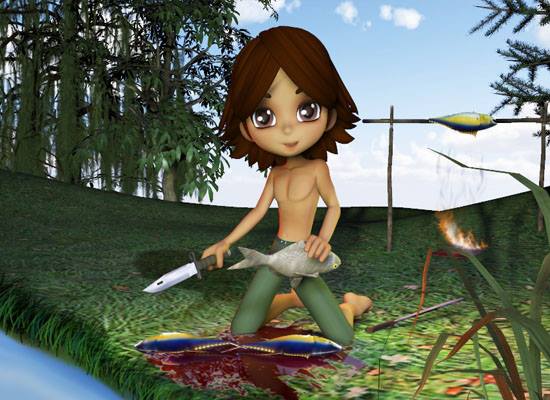Survival
Knife:
Your Best Tool for Chores Off the Grid
Choosing the best quality wilderness survival knife is important because it will most likely be your everyday work tool off the grid. For hunting, cleaning fish, making traps, cooking, wood cutting, digging the ground, self-defense, and more.
You may have seen the movie, Rambo, and seen how a good soldier and an outstanding knife can make a difference in jungle survival, never mind the killing parts. You can do a LOT to survive in the wilderness, or off the grid, with nothing but a good knife. Of course, Rambo is a little exaggerated, as most of us aren't even trained mercenaries, so a utility knife makes more sense than the stylized combat bowie knife used in the film.

Like we mentioned, a utility survival knife is your meal ticket, NOT a combat bowie knife.
Because of their aggressive design, 9 to 10 inch bowie knives are too heavy and not very practical for survival chores. Your hands will tire from using them all day long. Also, double-edged blades do not make good survival knives, more weapon than tool, they are not as useful for cutting and chopping. These also tend to have weak tips that can be chipped or broken off. Reliability of your survival blade is everything and a double- edged blade doesn’t have a thick spine, so it would be impossible to baton wood with it.
Long Bowies for Self-Defense:
If you can get two, one for everyday use, and one as a main self-defense weapon, the bowie knife is still not as good as a machete or a kukri for range and power strikes. But a bowie helps you in close quarters better if someone sneaks up on you and you need to save yourself and your loved ones.
FEATURES YOU NEED IN A SURVIVAL KNIFE:
Blade Steel:
Survival Knives generally come in two types of steel: Stainless or Carbon.
Stainless Steel is virtually indestructible, can take a beating and last a long time without rusting. Many people say stainless blades lose an edge faster than carbon.
Carbon Steel knives hold a good edge longer than stainless steel, but may rust faster in the elements.
Blade Shape:
Blades with thin or narrow points can break easily especially when digging. You want a sturdy point that can take plenty of abuse, but still be used for finer survival chores. A drop point blade is best for multi-purpose wilderness survival chores. Look for a blade with a good curved edge on the bottom called the belly, which comes in handy for food prep chores such as slicing and skinning.
Plain edge or serrated edge – Your daily wilderness survival knife should always have a plain edge. A serrated edge might be more useful in a city environment as its best strengths are for cutting synthetic materials such as rope and seat belts, plastic, etc. A plain edge can still do these things BUT do everything else a lot better. Plain edges are also hold an edge longer and are much easier to sharpen. A good smooth stone can be used to sharpen a straight blade if you are without a whetstone, whereas a serrated edge almost always takes a special dedicated sharpener.
Fixed blade – Survival knives must be durable, reliable and be able to take a lot of abuse. A folding knife isn’t any of these. Although a folder can make an excellent back-up knife, your primary survival knife should always be a fixed blade, preferably with a full tang. Full tang means that the blade and the tang (the part of the metal embedded in the handle ) are one solid piece of steel. The best for a quality survival knife. Full tang gives the entire knife strength. This adds extra strength and durability to the knife. On cheaper knives the blade is only connected to the top of the handle and can break off.
Blade Size – Wilderness survival knives must be sturdy enough to handle the abuse of outdoor survival yet small enough to be comfortable for smaller jobs. A good thickness for the blade should be around 1/8 inch or between 3 to 4 mm. This gives you enough strength for heavy duty jobs while still be effective at slicing and smaller tasks. A good blade length would be around 4 to 6 inches long or between 100 and 125mm.
Handle – A good handle should feel comfortable in your hand and be made of a durable solid material. Avoid handles that are hollow or plastic as they will not be dependable. A couple of nice features to have is a lanyard hold and a blunt flat edge at the end of the handle. Some are hard rubber, others polymer.
Sheath
--The sheath of your knife can seem less than important, however
the sheath will affect a lot about how you carry and draw your knife.
